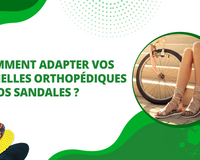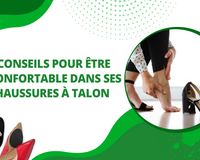
When this pathological form is associated with intense pain due to theplantar arch collapsethe consequences of flatfoot can be quite severe, including poor posture, chronic pain, balance and mobility problems, and long-term injury.
However, to prevent complications and relieve flatfoot pain, it is advisable to treat the underlying cause of flatfoot and consult a doctor for advice on the appropriate treatment to halt the progression of the condition.
From orthopedic flatfoot shoesflatfoot insoles, foot orthotics, stretching and strengthening exercises and, in extreme cases, surgery may be required to relieve pain and correct posture.
Flatfoot: a common pathology
Flatfoot is a deformity of the foot caused by the collapse of the arch of the foot. As a result, people with this type of foot are generally out of danger when it is not associated with pain.
However, it's important to know that, while not all forms cause pain, there are two types of flatfoot, namely physiological feet which are generally symptom-free, and pathological flat feet which are associated with pain.
Common causes of flatfoot

The causes of flatfoot are fairly common, and differ according to age. However, the most common are :
- Flatfoot in children aged 0 to 5 is common and requires no special treatment, as the foot forms naturally, which is why it may not be necessary to consult a doctor or specialist before the age of three.
- In adolescents, flatfoot is generally a sign of synostosis of the foot.
- In adults, there are many causes, including :
- Overweight,
- age,
- Trauma,
- Degenerative diseases,
- Ankle fragility
- Rheumatic diseases
- Etc.
Flat feet consequences

If left untreated, the pain felt in the arch of the foot due to the foot's morphology (flatfoot) can lead to a number of consequences:
Morton's neuroma
Morton's neuroma may be the first complication of untreated flatfoot. In fact, flatfoot can lead to excessive pressure on the metatarsal nerves between the toes, leading to symptoms such as tingling, pain and, above all, inflammation.
Tendonitis
People who suffer from ankle, foot or leg problems may find that flat feet can contribute to the onset of tendonitis. Tendonitis can cause intense joint and muscle pain, as well as stiffness and weakness in muscles and ligaments.
Toe deformities: hammertoes or hallux valgus
Hammer toe and hallux valgus are toe deformities that can be caused by untreated flatfoot pain. Here, hammertoe represents a deformity that occurs when a toe is bent downwards and especially inwards, which can cause discomfort and pain when walking.
As for valgus foot, this generally occurs when the big toe is deviated outwards and the base of the toe is displaced inwards. However, both plantar conditions are often caused by excessive pressure on the toes or by heredity, and can also result from untreated flat feet.
Pain in the hips, feet, ankles and knees
In flatfoot sufferers, pain in the hips, feet, ankles and knees is quite common. These flatfoot pains are most often caused by excessive pressure that is sometimes put on these joints when the flatfoot is in motion.
In addition, improper formation of the internal arch can also lead to instability during movement, and to a loss of mobility. reduced shock absorption. Over time, this improper use of the foot's bones and tendons can lead to chronic pain in the knees, lower back and hips.
Plantar fasciitis
Plantar fasciitis is known as inflammation and pain at the back of the arch of the foot, and is then linked to excessive pressure on the fascia that connects the heel to the toes. Plantar fasciitis can have a number of causes, including overweight and inappropriate footwear.
However, people with flat feet are generally more likely to suffer from plantar fasciitis, as their movement and posture are altered, which can cause excessive pressure on the fascia.
Types of flatfoot treatment
Orthopedic insoles for flat feet

Flat-foot orthotics are generally designed to support the arch of the foot and help patients relieve flat-foot pain. However, these flat-foot insoles can be custom-made or bought off-the-shelf. Smarfeet et are best suited to patients with flatfoot or postural abnormalities. So you can order your flat-foot insoles here to get the best flat-foot orthopedic insoles for you.
The advantage of these flat-foot insoles is that they can help distribute pressure evenly over the arch of the foot and protect the fascia, which can then reduce pain caused by arch drop.
Pharmacy flat foot insoles
As a reminder, a quick and economical way to buy flat-foot orthotics is, of course, to visit a pharmacy. Generally speaking, many pharmacies have heel pads or orthopedic insoles for flat feet available for purchase.
✅ Most pharmacies offer a wide range of shoe insoles to suit all budgets.
Which brand of shoe for flat feet?

The question immediately arises as to which brand of shoe to choose for flat feet. For people with this condition, wearing orthopedic flatfoot shoes is highly recommended. Wearing shoes that are too tight or too narrow can be a big problem, They can exert excessive pressure on the toes and arch.
It is therefore advisable to choose models with a much wider fit to reduce compression of the forefoot and toes, especially in cases of hallux valgus.
What's more, support and stability are one of the most essential aspects to look for, especially when you suffer from flat feet. That's why men's and women's flatfoot shoes won't bend towards the middle of the shoe.
Kinesitherapy and physiotherapy: the ideal solution
Physiotherapy can also be a solution for those suffering from pain caused by fallen arches (flat feet). With physiotherapy, the physiotherapist sets up posterior stretching physiotherapy sessions.
The main aim of these sessions, however, is to strengthen the posterior tibial tendon to counteract posterior hamstring insufficiency.
Flatfoot surgery: types of surgery
When all possible treatments fail to produce positive results, the flat-footed patient may be forced to undergo foot surgery to correct severe deformities.
However, there are two types of flatfoot surgery: conservative and non-conservative, depending on the degree of deformity and pathology diagnosed.









